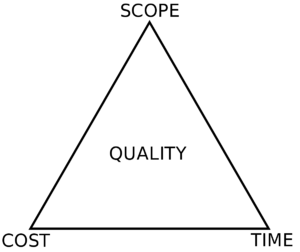The iron triangle as an analytical tool
| Line 21: | Line 21: | ||
| A program’s success is measured by the program’s ability to deliver its intended benefits to an organization, and by the program’s efficiency and effectiveness in delivering those benefits. | | A program’s success is measured by the program’s ability to deliver its intended benefits to an organization, and by the program’s efficiency and effectiveness in delivering those benefits. | ||
| Success is measured in terms of the aggregate investment performance and benefit realization of the portfolio. | | Success is measured in terms of the aggregate investment performance and benefit realization of the portfolio. | ||
| + | |} | ||
| + | |||
| + | {| class="wikitable" style="font-weight:bold; text-align:center; background-color:#efefef;" | ||
| + | |- | ||
| + | ! style="font-weight:normal; text-align:left;" | | ||
| + | ! style="background-color:#9aff99;" | Projects | ||
| + | ! Programs | ||
| + | ! Portfolios | ||
| + | |- style="text-align:left; background-color:#ffffff;" | ||
| + | | style="text-align:center; background-color:#efefef;" | Success | ||
| + | | style="background-color:#9aff99;" | Success is measured by product and project quality, <br />timeliness, budget compliance, and degree of customer satisfaction. | ||
| + | | style="font-weight:normal;" | A program’s success is measured by the program’s ability to deliver its intended benefits to an organization, <br />and by the program’s efficiency and effectiveness in delivering those benefits. | ||
| + | | style="font-weight:normal;" | Success is measured in terms of the aggregate investment performance <br />and benefit realization of the portfolio. | ||
|} | |} | ||
Revision as of 10:14, 21 February 2021
Contents |
Abstract
This article aims to present the Iron Triangle (also known as Project Management Triangle, Project Triangle, and Triple Constraint Triangle) with a focus on Project Management through the perspective of Purpose. The Iron Triangle is an analytical tool based on the essential triple constraints of project management; Time, Cost, and Scope/Quality. While scope and quality cannot be directly interchangeable with each other, the choice of constraint definition varies through literature, whereas the PMI standards most often use Scope, and the British standards, Quality. This article is initially going to refer to the triple constraints including Scope, as PMI’s Project Management Body of Knowledge, a key reference of this article, uses this standard.
Regarding the application of the tool, PMI’s Project Management Body of Knowledge courses of action regarding the management of the triple constraints will firstly be briefly introduced. Then, various practical and strategic approaches to the application of the triple constraints will be presented. Here, the perspective of the Four Levels of Management (Managing Successful Projects with PRINCE2) will be included to illuminate how the Iron Triangle should not only be considered from a management perspective but also a delivering perspective. Lastly, it will be discussed how the Iron Triangle can be leveraged from representing a set of pre-defined specifications (classic view of projects) to an analytical tool focusing on value creation (state of the art view of projects) based on relevant success criteria. Here the methodology of conformance (value protection) vs. performance (value creation) will also be included.
Through above-presented observations, various limitations of the Iron Triangle will also inevitably emerge. These will be presented including varying takes on the Iron Triangle which could mitigate these limitations. Some of the limitations could be: The Iron Triangle does not include all constraints regarding project success. The perspective of which the constraints of the Iron Triangle are measured can have varying effects on the application of the tool. Also, even with the above-presented courses of action regarding the managing of constraints, the risk of unrealistic and uncertain measuring of the constraints could have critical consequences regarding the application of the tool.
The Iron Triangle and its most relevant variations
| Projects | Programs | Portfolios | |
|---|---|---|---|
| Success | Success is measured by product and project quality, timeliness, budget compliance, and degree of customer satisfaction. | A program’s success is measured by the program’s ability to deliver its intended benefits to an organization, and by the program’s efficiency and effectiveness in delivering those benefits. | Success is measured in terms of the aggregate investment performance and benefit realization of the portfolio. |
| Projects | Programs | Portfolios | |
|---|---|---|---|
| Success | Success is measured by product and project quality, timeliness, budget compliance, and degree of customer satisfaction. |
A program’s success is measured by the program’s ability to deliver its intended benefits to an organization, and by the program’s efficiency and effectiveness in delivering those benefits. |
Success is measured in terms of the aggregate investment performance and benefit realization of the portfolio. |
Test [1]
Test [2]
Test. [3]
Test. [4]
Test. [5]
Test. [6]
Test. [3]
Application
Test.
Limitations
Test.
Annotated bibliography
Key references:
A guide to the Project Management Body of Knowledge (PMBOK guide), 6th Edition (2017)
Managing Successful Projects with PRINCE2, 6th Edition (2017)
Bibliography
- ↑ Pollack, J., Helm, J. and Adler, D. (2018), "What is the Iron Triangle, and how has it changed?", International Journal of Managing Projects in Business, Vol. 11 No. 2, pp. 527-547.
- ↑ AXELOS. Managing Successful Projects with PRINCE2 2017 Edition, The Stationery Office Ltd, 2017. pp. XXX. ProQuest Ebook Central, https://ebookcentral-proquest-com.proxy.findit.dtu.dk/lib/DTUDK/detail.action?docID=4863041.
- ↑ 3.0 3.1 Project Management Institute, Inc. (2017). Guide to the Project Management Body of Knowledge (PMBOK® Guide) (6th Edition) - 2. Initiating Process Group. Project Management Institute, Inc. (PMI). pp. XXX. Retrieved from https://app.knovel.com/hotlink/pdf/id:kt011DXQ4C/guide-project-management/initiating-process-group
- ↑ Wright, Andrew, and Therese Lawlor-Wright. “Project Success and Quality: Balancing the Iron Triangle.” Project Success and Quality: Balancing the Iron Triangle, Taylor and Francis, 2018, pp. 171–177. doi:10.4324/9781351213271.
- ↑ Roger Atkinson, Project management: cost, time and quality, two best guesses and a phenomenon, its time to accept other success criteria, International Journal of Project Management, Volume 17, Issue 6, 1999, Pages 337-342.
- ↑ Gabriella Cserháti, Lajos Szabó, The relationship between success criteria and success factors in organisational event projects, International Journal of Project Management, Volume 32, Issue 4, 2014, Pages 613-624. ISSN 0263-7863.



